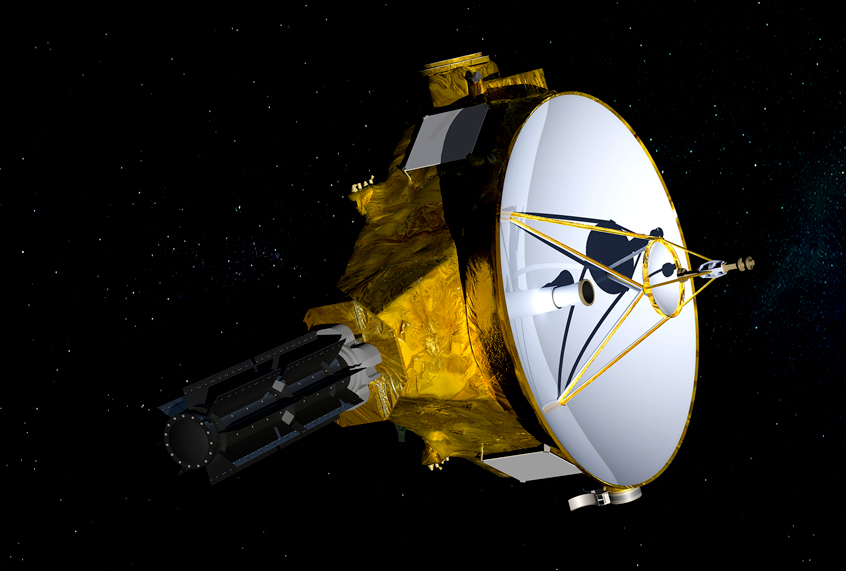It’s important to be well-rested before setting out on an adventure, whether you’re a human or a NASA spacecraft. Hence, this week, NASA’s New Horizons spacecraft woke up following its second 165-day hibernation period, in preparation to collect data on a mysterious, massive rock named Ultima Thule that orbits our sun at the edge of the solar system.
This week marks the beginning of an estimated two-month mission in which the New Horizons team will send the first of many commands to the spacecraft. In August, the team will start to make observations of Ultima Thule. New Horizons previously flew by Pluto in July 2015, providing the most detailed photos of the dwarf planet ever and forever changing the public’s understanding of the distant world. Yet the plucky little probe may be equally renowned once it collects data on this exotic rock that may give scientists unprecedented insight into the early formation of our solar system.
“Ultima Thule may very well be the most primitive object ever explored by a spacecraft,” Harold Weaver, New Horizons Project Scientist, told Salon in an email.
When referring to the object as “primitive,” Weaver explains Ultima Thule (he calls it “Ultima” for short) has hardly experienced any change since its original formation. Little is known about Ultima besides a few salient details. First, it is a member a family of Kuiper Belt Objects (KBOs) known as the “cold classicals,” Weaver said, which have “nearly circular” orbits around the sun and have not been agitated by contact with Neptune. The Kuiper Belt is the distant region of the solar system past Neptune’s orbit in which many icy bodies and comets idle by.
“For this reason, and because the temperatures are so frigid where they orbit, the cold classical objects are thought to be well-preserved relics from the time of the solar system’s formation,” he explained.
Weaver added that scientists believe Ultima’s surface reflectivity is low, meaning it is not made entirely of something shiny like water ice; indeed, observations indicate that its color appears red, which would suggest it is laminated in heavy organic molecules. Its shape is also non-spherical.
“The stellar occulation measurements conducted last summer show that Ultima’s shape is highly non-spherical, probably bi-lobed similar to what’s observed for many small objects in the solar system (e.g., comet 67P),” Weaver said. He added that it is approximately 20 miles in diameter in its longest dimension.
New Horizons’ observations of Ultima could provide insight into how the history of the solar system.
“When New Horizons observes Ultima, we’ll be essentially looking back more than 4 billion years to a time when the planets were forming and the solar system’s architecture was being sculpted,” Weaver explained. “The data gathered on Ultima will help constrain the physical and chemical environment of the early solar system, which will also be applicable to our understanding of exoplanetary systems (i.e., planetary systems around other stars).”
As observing technology has recently improved, research into exoplanets has boomed. In April, NASA launched the Transiting Exoplanet Survey Satellite, commonly known as TESS, a new research satellite whose mission is to gain a better understanding of exoplanets by creating a catalogue of them.
New Horizons will take high-resolution images of Ultima, Weaver said, that will impressively be twice as sharp as those obtained of Pluto.
“New Horizons will focus its color camera and infrared spectral imager on Ultima to measure its surface composition,” he said. “Are there ices on the surface? What causes Ultima to appear dark and reddish when observed from Earth?”
The data collected will also illuminate Ultima’s speculated shape, and its cameras will perform a search for dust rings.
As for New Horizons, while it is the spacecraft’s last planned flyby, Weaver said it continues to have a lot to offer scientists—and not to rule out another mission.
“A remarkable fact is that the New Horizons instruments and spacecraft subsystems have shown virtually no degradation over the entire lifetime of the mission (over 12 years and counting), and there is enough fuel and power available to conduct unique science well into the next decade,” he said. “However, NASA has not approved New Horizons operations past the spring of 2021; a second extended mission would have to be proposed and approved for the quest to continue,” he noted.

